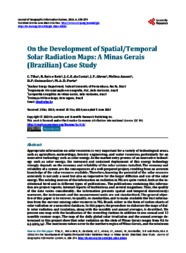On the development of spatial/temporal solar radiation maps: a Minas Gerais (Brazilian) case study.
On the development of spatial/temporal solar radiation maps: a Minas Gerais (Brazilian) case study.
Author(s): TIBA, C.; REIS E REIS, R.; COSTA, J. C. E. da; ABREU, J. F.; AMONI, M.; GUIMARAES, D. P.; PORTO, M. A. D.
Summary: Appropriate information on solar resources is very important for a variety of technological areas, such as agriculture, meteorology, forestry engineering, and water resources, particularly for an innovative technology such as solar energy. In the market entry process of an innovative technology such as solar energy, the increased and sustained deployment of this energy technology strongly depends on the economy and reliability of the solar systems installed. The economy and reliability of a system are the consequences of a well-prepared project, resulting from an accurate knowledge of the solar resource available. Therefore, knowing the potential of the solar resource accurately is not only a need but also an imperative for the larger diffusion and use of the solar energy. The existing sources of the information on radiation in MG are quite varied, both at the institutional level and in different types of publications. The publications containing this information are project reports, internal reports of institutions, and several magazines. Thus, the quality of the data varies considerably, the information presents spatial and temporal discontinuity; moreover, the instruments and the measurement units are not standardised. The general objective of this paper is to recover, to qualify, to standardize, and to make available the best information from the current existing solar resource in MG, Brazil, either in the form of isoline charts of solar radiation or a numerical database. In this paper, the procedure to elaborate the maps of daily solar radiation and insolation, along with the monthly and annual averages, is described. We present one map with the localisation of the recording stations in addition to one annual and 12 monthly contour maps. The map of the daily global solar irradiation and the annual average determined in this project show that solar radiation on the state of Minas Gerais ranges from 4.5 to 6.5 kWh/m2. The maximum values occur in the northern region of Minas Gerais, and the minimum values occur in the southeast region, where there are areas of higher altitude (Mantiqueira and Serra do Caparaó) and the rainfall is more intense, with total annual rainfall greater than 1400 mm. The North and Northeast Regions of MG, where the largest annual irradiation of 6.5 kWh/m2 occurs, are characterised by a semiarid climate with annual rainfall between 600 - 800 mm and altitudes between 400 - 600 m. The maritime tropical air mass that acts between Brazil and Africa is the main climatic factor that inhibits cloud formation and, consequently, the rainfall in this region. Finally, the map of annual insolation reveals a consistent correlation between the daily rainfall and the solar radiation annual average.
Publication year: 2014
Types of publication: Journal article
Unit: Embrapa Maize & Sorghum
Observation
Some of Embrapa's publications are published as ePub files. To read them, use or download one of the following free software options to your computer or mobile device. Android: Google Play Books; IOS: iBooks; Windows and Linux: Calibre.
Access other publications
Access the Agricultural Research Database (BDPA) to consult Embrapa's full library collection and records.
Visit Embrapa Bookstore to purchase books and other publications sold by Embrapa.

